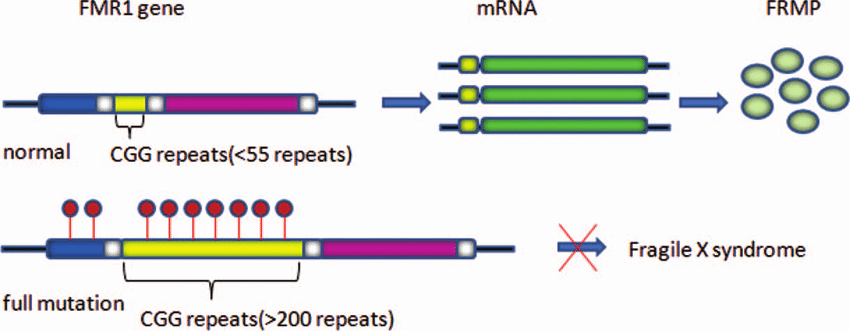
Fragile X syndrome (FXS):
- Fragile X syndrome is also known as marker X syndrome or Martin-Bell syndrome.
- It is one of the genetic disorders that is also considered as second most common cause for inherited mental disfunction after trisomy 21.
- It is manifested by various changes in the behavior and cognitive recognition that differs widely in severity among the patients.
- Both males and females are affected by it, but males are more likely to be severely affected in comparison to females.
- It has been estimated to affect 1 in 4000 boys whereas 1 in 8000 girls.
- Approximately 1 in 259 women of all races carry the fragile X gene and may transmit it to their children, whereas about 1 in 800 men of all races and ethnicities are carriers. Carrier females have a 30 to 40% chance of giving birth to a mentally retarded male child and a 15 to 20% chance of having a mentally retarded female child.
- Despite being an X chromosome recessive trait with changeable expression and partial penetrance, 30% of all carrier females are affected.
- Penetrance is the proportion of individuals carrying a particular variant of a gene which also express an associated trait or phenotype.
- It is lifelong condition and only few people with FXS can live independently.
Causes:
- A “fragile” site at the end of the long arm of the X chromosome results in Fragile X syndrome.
- Loss-of-function mutations in the fragile X mental retardation 1 (FMR1) gene causes Fragile X syndrome.
- FMR1 encodes the FMRP protein present in many tissues and at relatively high levels in the brain and testes.
- In the brain, it functions in the development of neuronal synapses and cell communication.
- The synapses can change and adjust over time in response to event, a feature called synaptic plasticity.
- The FMRP protein may aid in regulating synaptic plasticity and thus direct learning and memory.
- Fragile X syndrome fit in to an emerging class of neurodegenerative disorders known as trinucleotide repeat disorders. Out of these disorders, 14 affect humans and obtain neurological dysfunction.
- The inactivation of the FMR1 gene by trinucleotide CGG repeat expansions (200 to more than 1,000 repeats) are the most common mutations observed at this locus.
- The repeat expansion mutation results in high methylation in the FMR1 promoter region that halts transcription of FMR1.
- This expansion mutation is a null mutation (i.e., does not alter the function of the protein it codes for).
- Few typical alterations occur at this locus of FMR1.
- Array-based sequence analyses manifested that missense mutation (a single nucleotide change resulting in a codon that encodes a different amino acid) in FMR1 is not a common cause of the fragile X syndrome phenotype in patients who have normal-length CGG repeat tracts.
- Thus, screening for small deletions of FMR1 may be of clinical advantage.
- In most people who lack fragile X syndrome, the number of CGG repeats ranges from about 1 to 40. This CGG repeat segment is typically disrupted several times by a different trinucleotide, AGG.
- Having AGG scattered among the CGG trinucleotides aids to sustain the length of the long repeated segment.
- In patients with fragile X syndrome, the CGG trinucleotide is abnormally repeated from 200 to more than 1,000 times, resulting in instability of this region of gene.
- An unstable mutation is a mutation that has a high chances of reverting to its native form.
- The insertion of a controlling element (e.g., repeat expansion) can also result in unstable mutation whose subsequent deletion can result in a reversion to the original form of the gene.
- The inserted repeat expansion of the FMR1 gene turns it off, and it thus makes very little or no FMRP protein. A loss or reduction in the level of FMRP expression interrupts normal neuronal functions, causing severe learning problems, intellectual disability, and the other characters of fragile X syndrome.
- About 1 in 3 of males with an FMR1 gene mutation and the characteristic symptoms of fragile X syndrome also have characters of autism spectrum disorders that affect communication and social interaction. Other changes in FMR1 account for less than 1% of cases of fragile X syndrome.

Symptoms:
- Individuals with FXS show a combination of symptoms as children and throughout lifetime as follows:
- Developmental retardation:
-not being able to sit, walk, or talk at the same time as other children of the same age - Learning difficulties:
- trouble learning new skills
- Social and behaviour problems:
- not making eye contact
- anxiety
- delay in paying attention
- hand flapping
- acting and speaking without thinking
- Hyperactivity in case of children
- Highly sensitive to loud noises and bright light
- Other health problems:
- Seizures (Epilepsy)
- Hearing problems
- Vision problems
- Heart problems
- Physical symptoms:
- large ears
- flat feet
- long face
- Scoliosis
- testes enlarged in males after puberty
Diagnosis:
- The pregnant women undergo following tests to detect FXS in their babies:
1) Amniocentesis: a sample of amniotic fluid is tested for FMR1 gene.
2) Chorionic villus sampling (CVS): cells from placenta are checked for the FMR1 gene. - The person’s DNA from blood test confirms the FXS.
- Both karyotyping and DNA test are advised for the diagnosis.
- Southern blot and PCR are techniques for genetic analysis in present condition.
Treatment:
- No any medications or cure is available for FXS, thus the management and cure is a must for the individuals.
- Medications as such methylphenidate, guanfacine, clonidine, etc are prescribed for the attention deficit disorder or anxiety.
- Treatments include managing the symptoms that includes:
- Speech therapy
- Behaviour therapy
- Special education to help them learn
- Neurologist consultations for seizures
- Occupational and physical therapist
- People with FXS, parents, teachers and therapists should work closely with one another for the best treatment plans.
References:
- https://ghr.nlm.nih.gov/condition/fragile-x-syndrome#diagnosis
- https://www.cdc.gov/ncbddd/fxs/facts.html
- https://www.webmd.com/children/what-is-fragile-x-syndrome#1
- https://emedicine.medscape.com/article/943776-overview
- https://www.healthline.com/health/fragile-x-syndrome#treatment
- https://www.aafp.org/afp/2005/0701/p111.html
- help with biology homework
